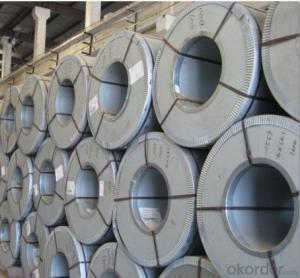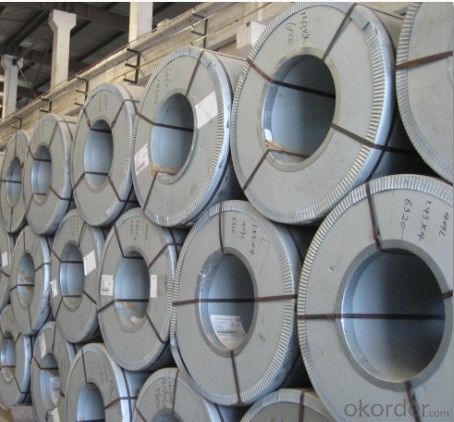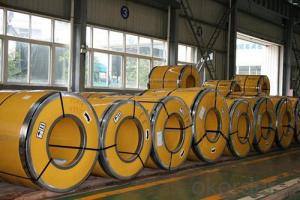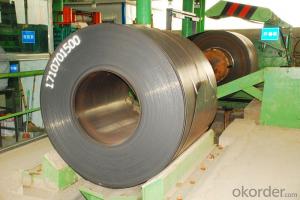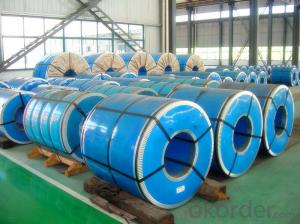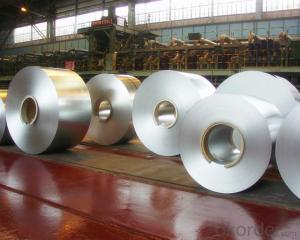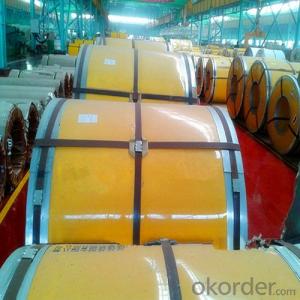Hot Rolled Stailess Steel Coil 200 Serious
- Loading Port:
- Shanghai
- Payment Terms:
- TT OR LC
- Min Order Qty:
- 25 m.t.
- Supply Capability:
- 100000 m.t./month
OKorder Service Pledge
OKorder Financial Service
You Might Also Like
Hot Rolled Stailess Steel Coil 200 Serious
1.Structure of Hot Rolled Stailess Steel Coil 200 Serious
Hot rolled stainless steel strip with good quality is one of the raw material of the cold rolled stainless steel strip, which can be used directly in many places. Stainless Steel (Stainless Steel) is short for acid-proof Stainless Steel, resistant to weak corrosive medium such as air, steam, water, or with a Stainless Steel grade.
2.Main Features of Hot Rolled Stailess Steel Coil 200 Serious
1) weldability of the hot rolled stainless steel coil 200 serious is good.
2) Corrosion resistance of the hot rolled stainless steel coil 200 serious is good.
3) Polishing performance of the hot rolled stainless steel coil 200 serious is good.
4) Heat resistant performance of the hot rolled stainless steel coil 200 serious is good.
3. Hot Rolled Stailess Steel Coil 200 Serious Images
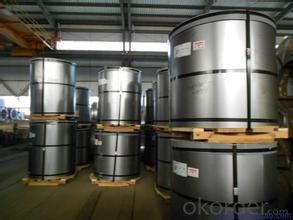

4. Hot Rolled Stailess Steel Coil 200 Serious Specification
The word "stainless steel" is not merely refers to a pure stainless steel, but said more than one hundred kinds of stainless steel industry, the development of each stainless steel has good performance in their specific applications. The key to the success of the first is to make clear purpose, and then determine the correct material. Related to architectural construction applications usually only six types of steel. They contain 17 ~ 22% chromium, good steel contains nickel. Add molybdenum can further improve the atmospheric corrosion resistance, especially containing chloride atmospheric corrosion resistance. Stainless steel often according to the state of organization can be divided into: martensite steel, ferritic steel, austenitic steel, austenitic (two-phase) - ferrite stainless steel and precipitation hardening stainless steel, etc. In addition, according to ingredients can be divided into: chromium stainless steel, chromium nickel stainless steel and chromium manganese nitrogen stainless steel, etc.
1) Ferritic stainless steel Chromium containing 15% ~ 30%. Its corrosion resistance, toughness and weldability with chromium content increases with the increase of chloride stress corrosion resistance is superior to other types of stainless steel, fall into this category of Crl7, Cr17Mo2Ti, Cr25, Cr25Mo3Ti, Cr28, etc. Ferritic stainless steel because of the high chromium content, corrosion resistance and oxidation resistance are relatively good, but the mechanical properties and process performance is poorer, more used to stress less acid structure and steel used as antioxidant. This kind of steel to withstand atmosphere, nitric acid and corrosion of the brine solution, and has good high temperature oxidation resistance, low thermal expansion coefficient, etc, used in nitric acid and food factory equipment, also can make work under high temperature parts, such as gas turbine parts, etc.
2) Austenitic stainless steel The title Chromium is more than 18%, still contain about 8% of the nickel and small amounts of molybdenum, titanium, nitrogen and other elements. Good comprehensive performance, corrosion resistant to a variety of media. Number of austenitic stainless steel is commonly used one cr18ni9, 0 cr19ni9, etc. In the Wc < 0.08% 0 cr19ni9 steel, steel grade is marked as "0". This class contains large amounts of Ni and Cr in steel, make steel in austenitic state at room temperature. This kind of steel has good plasticity and toughness, weldability and corrosion resistance and non-magnetic or weak magnetic, the corrosion resistance in oxidizing and reducing medium are good, used to make acid equipment, such as corrosion resistant containers and equipment lining, pipelines, nitric acid resistant equipment parts, etc., also can be used as the main body of watches and clocks jewelry stainless steel material. Austenitic stainless steel with solid solution treatment, the steel heating to 1050 ~ 1150 ℃, then water-cooled or air-cooled, for single-phase austenitic organization.
3) Austenitic, ferritic duplex stainless steel The advantages of both austenitic and ferritic stainless steel, and has the superplasticity. Austenite and ferrite The title Each accounts for about half of the stainless steel. In the case of contain low C, Cr content was 18% ~ 18%, Ni content at 3% ~ 3%. Some steel containing Mo, Cu, Si, Nb, Ti, N and other alloying elements. This kind of steel both austenite and ferrite stainless steel, the characteristics of compared with ferrite, plasticity and toughness is higher, no room temperature brittleness, intergranular corrosion resistance and welding performance were significantly increased, while maintaining a ferritic stainless steel of 475 ℃ brittleness and high thermal conductivity, has the characteristics of superplasticity. Compared with austenitic stainless steel, high strength and resistance to intergranular corrosion and resistance to chloride stress corrosion is improved obviously. Duplex stainless steel has excellent resistance to pitting corrosion performance, is also a kind of nickel and stainless steel.
4) Precipitation hardening stainless steel For austenitic or martensite structure matrix, and the number of precipitation hardening stainless steel commonly used such as 04 cr13ni8mo2al. It can pass the precipitation hardening (also known as the age hardening) dealing with the hard (strong) of stainless steel.
5) Precipitation hardening stainless steel For austenitic or martensite structure matrix, and the number of precipitation hardening stainless steel commonly used such as 04 cr13ni8mo2al. It can pass the precipitation hardening (also known as the age hardening) dealing with the hard (strong) of stainless steel.
5.FAQ of Hot Rolled Stailess Steel Coil 200 Serious
We have organized several common questions for our clients,may help you sincerely:
①How about your company?
A world class manufacturer & supplier of castings forging in carbon steel and alloy steel,is one of the large-scale professional investment casting production bases in China,consisting of both casting foundry forging and machining factory. Annually more than 8000 tons Precision casting and forging parts are exported to markets in Europe,
②How to guarantee the quality of the products?
We have established the international advanced quality management system,every link from raw material to final product we have strict quality test;We resolutely put an end to unqualified products flowing into the market. At the same time, we will provide necessary follow-up service assurance.
③Could I have an example of description of your products?
Detailed Information
| Product | 200 series hot rolled stainless steel |
| Grade | 202 (1.4373) 201 (1.4372) |
| Standard | ASTM,AISI,JIS,GB,DIN,etc. |
| Surface | hot rolled |
| Thickness | 3-120mm |
| Width | 1000/1500/2000mm or as your demand |
| Length | 1000-6000mm or as your demand |
| Surface technique | hot rolled |
| Finish | No1,polish |
| Origin | China |
| Delivery | 7-15 days after the order |
| Packing | Export standard package The inner size of container is below: 20 ft GP:5.8m(length)x 2.13m(width)x 2.18m(high) about 24-26 CBM 40 ft GP:11.8m(length)x 2.13m(width)x 2.72m(high)about 68 CBM |
| Application | Medical equipment, Food industry, Construction material, Kitchen utensils,Electric equipment,Decoration industry,Metallurgy, Electric warmer plate and so on. |
Could I have an example of description of Chemical Composition?
| grade | C | Cr | Ni | Mn | P | S | Mo | Si | Cu | N | Other |
| 201 | ≤0.15 | 16.00-18.00 | 3.50-5.50 | 5.50-7.50 | ≤ 0.060 | ≤ 0.030 | - | ≤ 1.00 | - | ≤0.25 | |
| 202 | ≤0.15 | 17.00-19.00 | 4.00-6.00 | 7.50-10.00 | ≤ 0.060 | ≤ 0.030 | - | ≤ 1.00 | - | ≤0.25 |
Could I have an example of description of standard?
| ASTM | USA | Ameirican Society of Mechanical Engineers |
| AISI | USA | Acronym of American Iron and Steel Institute |
| JIS | JP | Japanese Industrial Standards |
| DIN | GER | Deutsches Institut für Normung e.V. |
| GB | CHINA | GUO BIAO |
- Q: What is the maximum temperature stainless steel strips can withstand?
- The specific grade of stainless steel being used determines the maximum temperature it can withstand. Stainless steel is generally recognized for its ability to resist high heat and can endure temperatures up to 1450°C (2642°F) without significant changes in structure or mechanical properties. However, it should be emphasized that prolonged exposure to elevated temperatures may cause oxidation and scaling on the stainless steel's surface, potentially impacting its performance. Moreover, various grades of stainless steel possess different levels of heat resistance, underscoring the importance of consulting the manufacturer's specifications or a materials engineer for precise information regarding the maximum temperature tolerance of particular stainless steel strips.
- Q: Can stainless steel strips be used for heat exchanger tubes?
- Yes, stainless steel strips can be used for heat exchanger tubes. Stainless steel is a popular choice for heat exchanger applications due to its excellent corrosion resistance, high temperature resistance, and durability. Stainless steel strips can be formed into tubes of various shapes and sizes to accommodate different heat exchanger designs and requirements. Additionally, stainless steel offers good thermal conductivity, allowing for efficient heat transfer in the exchanger. Overall, stainless steel strips are a suitable and commonly used material for heat exchanger tubes.
- Q: Can stainless steel strips be used in the medical implants?
- Yes, stainless steel strips can be used in medical implants. Stainless steel is often chosen for medical implants due to its high strength, corrosion resistance, and biocompatibility. It is commonly used for various applications, such as orthopedic implants, surgical instruments, and cardiovascular devices.
- Q: How do stainless steel strips perform in the presence of alkalis?
- Stainless steel strips generally perform well in the presence of alkalis. The corrosion resistance of stainless steel is primarily due to the presence of chromium, which forms a passive oxide layer on the surface of the steel. This oxide layer prevents the steel from reacting with the surrounding environment, including alkalis. Alkalis, such as sodium hydroxide (caustic soda) or potassium hydroxide, are typically strong bases that have a high pH. Stainless steel is known for its resistance to corrosion in alkaline environments, as the passive oxide layer provides a strong barrier against the alkali's attack. However, it is important to note that the performance of stainless steel in alkalis can vary depending on the specific grade of stainless steel being used and the concentration and temperature of the alkali solution. In some cases, highly concentrated or elevated temperatures can lead to localized corrosion or stress corrosion cracking in stainless steel. To ensure optimal performance, it is recommended to select the appropriate grade of stainless steel based on the specific alkali being used, and to consider factors such as concentration, temperature, and exposure time. Consulting with corrosion experts or stainless steel manufacturers can provide further guidance on the best stainless steel grade for a specific alkali application.
- Q: Can stainless steel strips be used for chemical processing equipment?
- Yes, stainless steel strips can be used for chemical processing equipment. Stainless steel is highly resistant to corrosion and can withstand exposure to various chemicals, making it a suitable material for manufacturing equipment used in chemical processing.
- Q: How do stainless steel strips resist erosion?
- Due to its unique composition and properties, stainless steel strips possess the capacity to withstand erosion. Primarily, stainless steel is an alloy containing a high chromium content, resulting in a protective layer of chromium oxide forming on its surface. This layer acts as a barrier, preventing oxygen and moisture from reaching the underlying metal, thus safeguarding it against corrosion and erosion. Furthermore, stainless steel strips exhibit exceptional resistance to acids, alkalis, and various chemicals, making them suitable for usage in harsh environments. The presence of other alloying elements like nickel and molybdenum further enhances the corrosion resistance of stainless steel. Moreover, the structure of stainless steel, especially austenitic stainless steel, provides excellent strength and toughness, enhancing its resistance against mechanical erosion. The combination of corrosion resistance and mechanical properties enables stainless steel strips to endure erosive forces and exhibit high durability. Additionally, various surface finishes such as passivation or electro-polishing can be applied to stainless steel strips, further bolstering their resistance to erosion. These treatments eliminate impurities and contaminants from the surface, resulting in a smoother and more corrosion-resistant finish. In conclusion, the ability of stainless steel strips to resist erosion stems from their corrosion-resistant composition, surface treatments, and outstanding mechanical properties. These attributes render stainless steel an ideal material for numerous applications where erosion resistance is critical, such as the production of automotive components, kitchen appliances, and chemical processing equipment.
- Q: How do you join stainless steel strips together?
- Stainless steel strips can be joined together using various methods such as welding, soldering, or using mechanical fasteners such as screws or bolts. Welding is the most common and effective method, which involves melting the edges of the strips together to create a strong bond. Additionally, soldering can be used for thinner strips, where a filler metal is melted between the strips to join them. Mechanical fasteners provide a non-permanent solution and can be used when disassembly might be required.
- Q: Are 111 stainless steel strips resistant to pitting and crevice corrosion?
- 111 stainless steel strips exhibit resistance to pitting and crevice corrosion. With its high chromium content, stainless steel grade 111, or AISI 111, offers exceptional corrosion resistance. Furthermore, the inclusion of molybdenum further boosts its ability to withstand pitting and crevice corrosion, making it a suitable option for applications where such corrosion is a concern. Consequently, when corrosion resistance is necessary, 111 stainless steel strips prove to be a dependable selection.
- Q: What are the recommended cleaning and maintenance practices for 111 stainless steel strips?
- The recommended cleaning and maintenance practices for 111 stainless steel strips include regular wiping with a mild detergent solution and a soft cloth to remove any dirt or grime. Avoid using abrasive cleaners or scrubbers as they can scratch the surface. Additionally, it is important to dry the strips thoroughly after cleaning to prevent water spots or rusting. For maintenance, periodic polishing with a stainless steel cleaner can help maintain the shine and prevent oxidation.
- Q: How are stainless steel strips different from carbon steel strips?
- Stainless steel strips and carbon steel strips differ in various aspects, making them suitable for different applications. The main distinction lies in their composition and the presence of additional elements. Stainless steel strips are primarily composed of iron and chromium, with the addition of other elements such as nickel, molybdenum, and manganese. This composition gives stainless steel its corrosion-resistant properties, making it ideal for applications where exposure to moisture or chemicals is expected. Additionally, stainless steel strips possess excellent heat resistance, making them suitable for high-temperature environments. On the other hand, carbon steel strips consist mainly of iron and carbon, with minimal amounts of other elements. Carbon steel is known for its strength and durability, making it suitable for applications that require high tensile strength and hardness. However, carbon steel is susceptible to corrosion, especially when exposed to moisture or certain chemicals. Another key difference between stainless steel and carbon steel strips is their appearance. Stainless steel has a distinct silver-gray color and a smooth, shiny surface, giving it an aesthetically pleasing look. Carbon steel, on the other hand, usually has a duller appearance, with a rougher surface texture due to the presence of impurities. Furthermore, stainless steel strips are more expensive than carbon steel strips due to the additional elements used in their composition, as well as their superior corrosion resistance and other properties. This cost difference is an important consideration when choosing between the two materials for a specific application. In summary, stainless steel strips and carbon steel strips differ in terms of their composition, corrosion resistance, heat resistance, appearance, and cost. Understanding these differences is crucial in selecting the appropriate material for a particular application, ensuring optimal performance and longevity.
Send your message to us
Hot Rolled Stailess Steel Coil 200 Serious
- Loading Port:
- Shanghai
- Payment Terms:
- TT OR LC
- Min Order Qty:
- 25 m.t.
- Supply Capability:
- 100000 m.t./month
OKorder Service Pledge
OKorder Financial Service
Similar products
Hot products
Hot Searches
Related keywords
